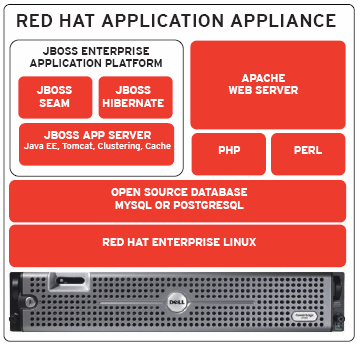Launched in October, the appliance is based on a Dell PowerEdge 2970 server and the Red Hat Application Stack, which includes the Apache web server, MySQL database and JBoss application server.

The Dell Red Hat Application Appliance makes deploying web and JBoss applications extremely easy. Service and support offerings provide excellent cover for remote site deployments.
As well as making it extremely quick and easy for administrators to deploy applications, once deployed, the service and support package makes it easy to keep them running with minimum effort. For example, the appliance comes with a subscription to the Red Hat Network (RHN), which enables IT staff to install software and updates from a browser connected to the RHN web site.
Administrators can also store sever configurations in their RHN profile so they can be deployed to new or replacement server hardware with the minimum effort. RHN can also monitor server configurations and automatically brings systems back into line should patching or other maintenace adversly affect their configuration. In short, this is remote management par excellence.
Dell and Red Hat hope firms will buy the appliance rather than building and maintaining their own application servers. They also hope software developers will install their applications on the appliance and sell the whole package to their customers. Red Hat would keep the software up to date using the RHN, and Dell would provide front line support. If there is a problem, the first port of call is Dell to check if it’s a hardware fault. If not, the call would be escalated to Red Hat Linux and application stack experts could take over. Depending on the purchase agreement, Dell would probably diagnose problems over the phone. Likewise Red Hat provides phone or onsite support for software issues. There’s a range of support offerings ranging from a three years deal guaranteeing a response on the next business day, up to 2 hours response times on a 24/7 basis.
In terms of hardware, the Dell PowerEdge 2970 is a midrange server fitted with two dual core AMD Opteron processors and 4GB RAM. It comes in a 2U rack mountable chassis complete with dual USB sockets and a connection for a monitor on the front panel, plus dual Gigabit Ethernet connectors, dual USB, serial and monitor connections on the rear panel.
Our system was supplied with a single power supply and three 36GB SAS hard disks. The hard disks were 15K RPM hot pluggable models fitted into sockets on the front panel. There was also a DVD ROM drive fitted to our system.
In The Hypervisor lab tests, we needed to fit a USB mouse, keyboard and a monitor so we could configure password and network settings, and of course, add the device to our RHN subscription. Once the initial setup had been performed, we removed the keyboard, mouse and monitor and managed the device remotely. For simple monitoring there’s a set of web based management tools, which for security reasons are only available to “localhost” connections. We used SSH with port forwarding to make these available to a remote PC. More detailed system administration tasks could be done using an SSH remote console, or using a remote screen display.
We tested the system by downloading some demo applications from jboss.org. Deployment of JBoss applications is done by dropping them into the “deploy” directory. The JBoss software automatically found them and added them to the configuration. We also installed the open source WordPress content management system and SugarCRM packages simply by copying an archive containing the latest versions to the appliance and unzipping them into the web server directory. We also needed to update the Apache server configuration and add suitable user accounts to the MySQL database. A few changes were also needed to our PHP configuration, but in each case we deployed the application software in less than five minutes.
Although there were no tools in the appliance specifically to help with this process, the Red Hat Application Stack includes the Gnome graphical desktop environment. This means users of Red Hat Enterprise Linux will find the AS version extremely similar, except of course, AS version also has the various application stack components.
On one occasion we used the File Browser tool that’s part of the Red Hat desktop to copy an EAR file to the deploy directory. We deployed WordPress and SugarCRM using an SSH console, and copying the file to the deploy directory.
Although the appliance is sold direct by Dell, currently it’s not on the Dell web site, so you need to phone Dell to buy it.